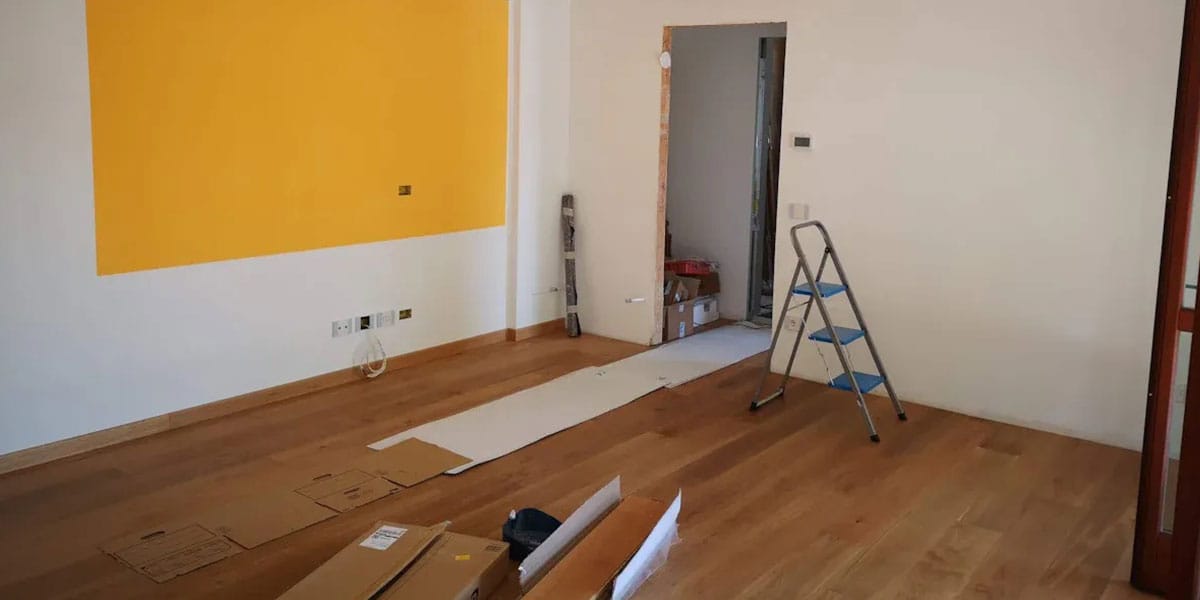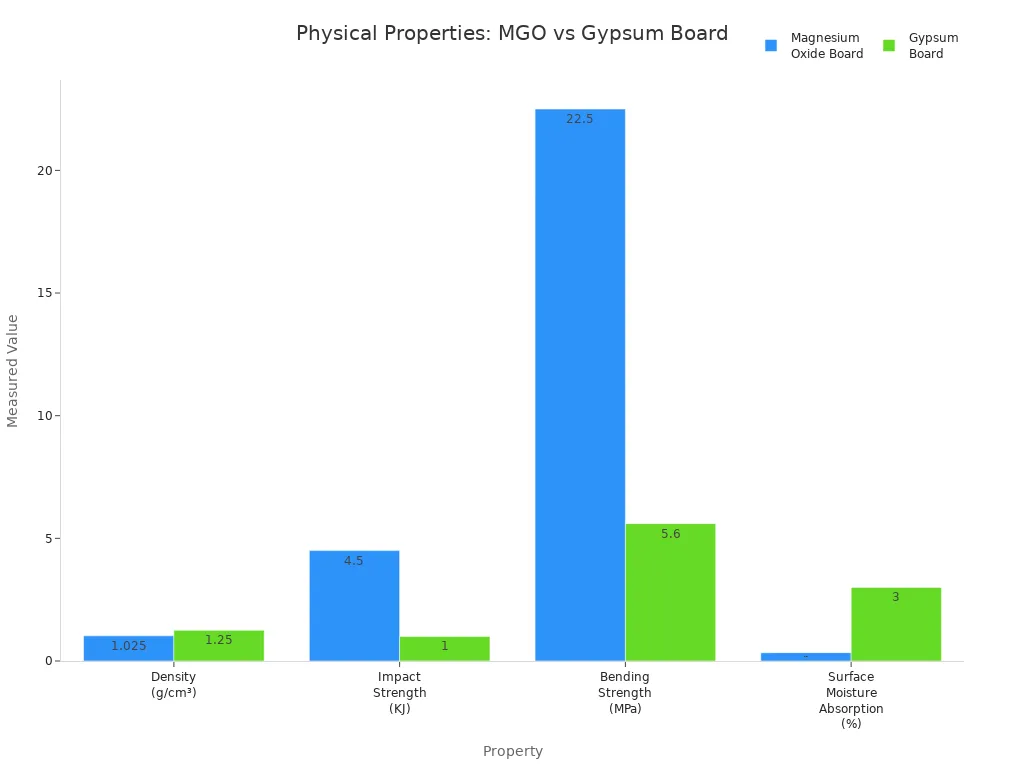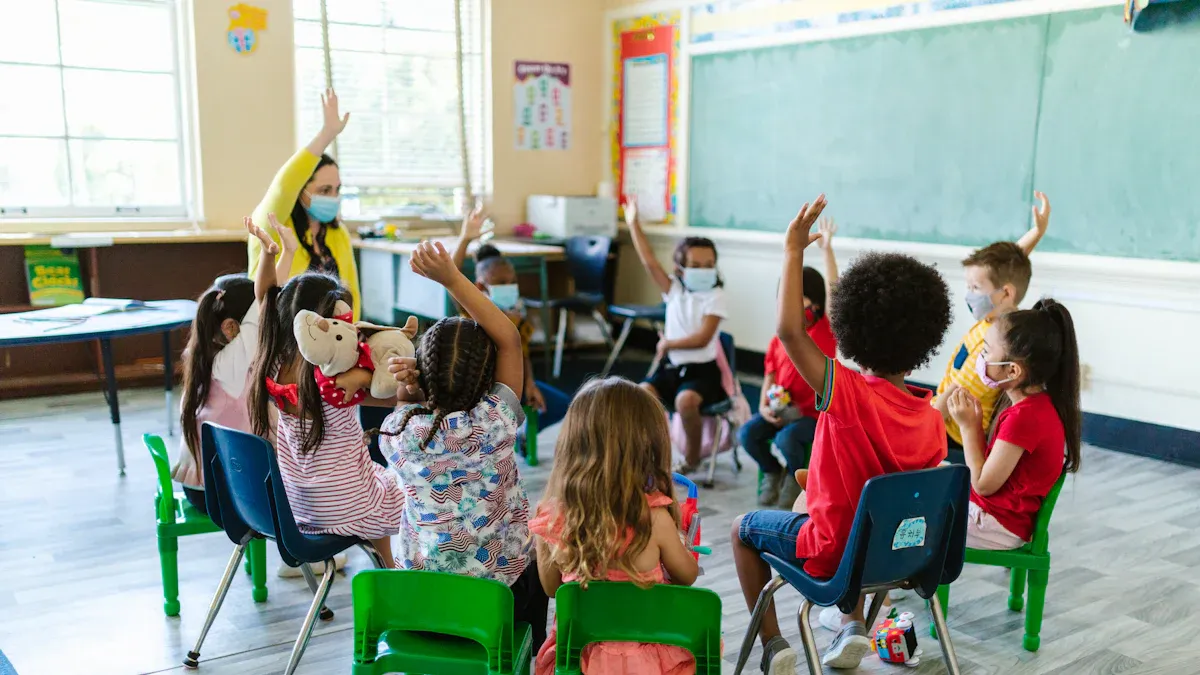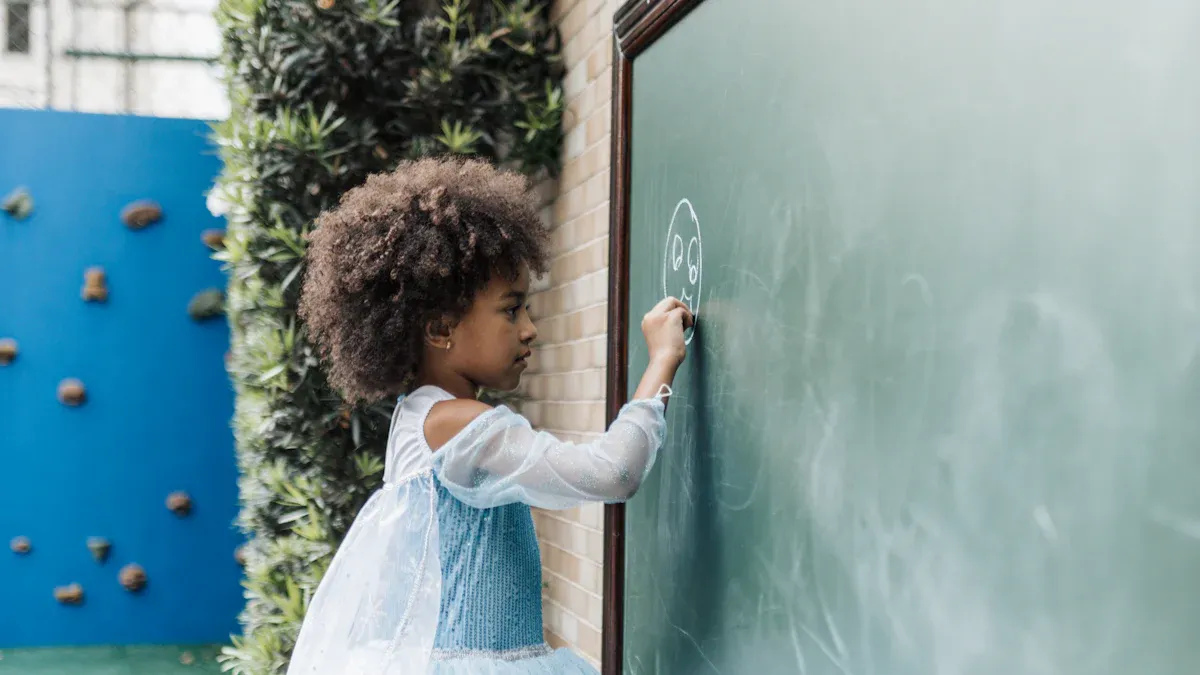
02 Sep A Practical Guide to Using Magnesium Wall Board in Kindergarten Projects
Table of Contents
You need a safe and dependable material for projects. Magnesium wall board is very good at stopping fires. It lasts a long time and keeps out water well. It helps classrooms stay clean. It also helps keep the air healthy inside. If you pick this material, you help the environment. This is good for young students.
Tip: Magnesium wall board helps you feel sure about safety and caring for the planet.
Key Takeaways
Magnesium wall board is very strong against fire and water. This helps keep classrooms safer for kids.
This material can last more than 30 years. It does not get mold, damage, or wet easily. This means you do not need to fix or replace it often.
It is good for the environment. It keeps classroom air clean because it does not let out bad chemicals.
You need to plan, install, and control moisture the right way. This stops problems like mold and rust.
Using certified boards and checking walls often keeps the classroom healthy. It also makes the space strong and nice for learning.
Magnesium Wall Board Overview
What Is It?
You might ask how magnesium wall board is not like other building materials. This board’s main part is magnesium oxide. Manufacturers mix it with magnesium sulfate, perlite, wood fibers, and fiberglass mesh. These things make the board strong, safe, and light. People use this board in places where safety and strength are very important, like kindergartens.
Here is a table that shows how magnesium wall board and gypsum board are different:
Attribute | Magnesium Oxide Board (MGO) | Gypsum Board |
|---|---|---|
Chemical Composition | Magnesium oxide, magnesium sulfate, perlite, wood fibers, fiberglass mesh | Mainly gypsum with paper facings |
Fire Resistance | Meets fire standards at 3 mm; tested at 750°C | Needs 12 mm to meet fire standards |
Water Resistance | Highly water-resistant; survives 100 days submerged | Poor water resistance; absorbs more moisture |
Density | 0.85–1.2 g/cm³ | 1.2–1.3 g/cm³ |
Impact Strength | >4.5 Kilo Joules | <1 Kilo Joule |
Bending Strength | 18–27 MPa | <5.6 MPa |
Environmental Impact | Eco-friendly, non-toxic, saves energy | Less eco-friendly, energy-intensive |
Ease of Installation | Easy, no special tools needed | May need professionals and tools |

Note: Magnesium wall board is great at stopping fire and water. This makes it a smart pick for classrooms.
Key Properties
You want a material that keeps kids safe and rooms clean. Magnesium wall board has many good features for kindergartens:
Fire Resistance: The board passes hard fire tests like EN 13501-1 and ASTM E84. It can take high heat and still work well.
Moisture Resistance: The board does not soak up much water. It will not swell or bend, even if it gets wet or cold for a long time.
Durability: The board can last more than 30 years. It stays strong and keeps its shape, even in rough places.
Mold Prevention: The board’s surface and high alkalinity stop mold from growing. This helps keep the air safe for young kids.
Lightweight and Easy Handling: The board is light and simple to move. You do not need special tools, so it is good for school projects.
Tests show magnesium wall board keeps its shape and strength for many years. It does not have the “crying” effect, which can cause mold or rust in other boards. Surface treatments, like melamine paper, give extra safety from fire, water, and scratches. These things make magnesium wall board a safe and strong choice for building in kindergartens.
Benefits

Safety
Every classroom should be safe for kids. Magnesium wall board helps make this happen. It does not catch fire easily. It can handle very high heat. This makes it a good shield against fire. The board does not let out bad chemicals. It has no formaldehyde, asbestos, or silica. You can cut and put it up without worrying about harmful dust.
Note: Research shows magnesium wall board is safer than many other materials. Over 1,000 samples were tested for more than two years. They stayed safe and stable, even in warm and damp classrooms.
The board also stops mold and mildew from growing. Its high alkalinity and low water absorption keep it clean and dry. This matters for young kids who are sensitive to air. Using this board helps stop allergies and breathing issues.
Durability
Kindergarten rooms get used a lot every day. You need walls that can take hits, scratches, and spills. Magnesium wall board is much stronger than drywall. It does not crack, crumble, or get ruined by water. You can hang shelves or art on it without extra help. The board does not swell or get weak, even if it gets wet.
It keeps its shape and strength for many years.
It is light but tough, so you use less and get more.
Many schools and hospitals use this board because it lasts long and needs little care. You save money and time since you do not fix or replace walls often.
Sustainability
You want to protect the planet and make healthy choices for students. Magnesium wall board helps with green building goals. It is made from natural and recyclable things. The board does not give off VOCs, which can cause headaches and allergies. This keeps the air clean and safe for kids.
Here is a table showing some important environmental certifications for magnesium wall board:
Certification/Report Type | What It Means for You and Your Students |
|---|---|
VOC Report | Shows the board does not release harmful chemicals into the air |
Material Safety Data Sheet (MSDS) | Gives details about chemical safety and environmental impact |
ICC-ES Environmental Programs | Proves the board meets strict green building standards |
ILAC-MRA Accredited Laboratory Testing | Confirms reliable safety and environmental test results |
Release of Dangerous Substances Testing | Ensures the board does not emit dangerous substances |
Fire Safety Certifications (EN 13501, ASTM E84, etc.) | Confirms the board stays safe and stable during a fire |
Third-Party Approvals (INTERTEK, BBA, etc.) | Independent experts check the board for safety and environmental standards |
Tip: Many schools have won green awards by using certified magnesium wall board. You can help your school be healthier and better for the planet.
Magnesium wall board helps you make a classroom that is safe, strong, and good for the earth. You give students a better place to learn and grow.
Installation
 Planning
Planning
You start by making a good plan for your kindergarten project. You choose the right size and thickness for each wall. You check the classroom layout and measure the space. You look for places where water might get in, like near sinks or windows. You pick certified products that meet fire safety standards. You ask for test reports and safety certificates from your supplier. You make sure the magnesium wall board fits your local building codes.
Tip: Always use boards that have passed fire tests like EN 13501-1 or ASTM E84. This keeps your classroom safe.
You think about moisture management. You keep the boards dry before installation. You store them off the ground and away from rain. You plan for proper ventilation in the classroom. You talk with your contractor about curing time and surface treatments.
Process
You begin by preparing the walls. You clean the surface and remove dust. You mark the spots for each board. You use a level to keep the boards straight. You cut the boards with a utility knife or saw. You wear a mask to avoid breathing in dust.
You attach the boards to the wall frame with screws. You space the screws about every 12 inches. You keep the edges tight but not too close. You leave a small gap at the bottom for expansion. You check each board for cracks or chips before installing.
Here is a simple checklist for installing magnesium wall board in a kindergarten:
Step | What You Do | Why It Matters |
|---|---|---|
Measure and Plan | Mark wall size and board layout | Ensures proper fit |
Prepare Surface | Clean and dry wall area | Prevents mold and damage |
Cut Boards | Use knife or saw for right size | Fits boards to space |
Attach Boards | Screw boards to frame | Keeps walls strong |
Check Alignment | Use level for straight lines | Looks neat and professional |
Leave Expansion Gap | Small gap at bottom | Prevents warping |
Note: Always use tested and certified boards. This protects students and meets safety rules.
You keep the classroom clean during installation. You sweep up dust and scraps. You check for sharp edges and smooth them out.
Finishing
You finish the walls by sealing the joints. You use joint tape and filler to cover gaps. You sand the surface until it feels smooth. You apply a primer to help paint stick. You choose paints that are safe for children. You let the walls dry before moving furniture back.
You check for moisture problems after finishing. You look for leaks near sinks or windows. You keep the classroom well-ventilated. You inspect the walls every few months for signs of mold or damage.
Tip: Good finishing helps the magnesium wall board last longer and keeps the classroom safe.
You can add surface treatments like melamine paper for extra protection. You use child-friendly colors and finishes. You make sure the classroom looks bright and welcoming.
Challenges
Moisture Issues
You need to watch out for moisture problems when you use magnesium wall board in kindergartens. High humidity can cause the board to form water droplets on its surface. People call this “crying” or “sweating.” These droplets can lead to mold growth and stains on nearby walls or floors. If you see salty water leaking from the board, it can damage wood and metal parts in the classroom. The salty water speeds up rust on metal fasteners, steel frames, and even zinc flashings. In some schools, this corrosion has happened in just one or two years. You may also notice cracks or other damage to the boards themselves. These problems have led to expensive repairs in some countries. You can lower the risk by keeping the classroom dry and using stainless steel fasteners.
Note: Always check for signs of moisture or mold after installing magnesium wall board. Early action can prevent bigger problems.
Air Quality
You want clean air for your students. Magnesium wall board does not release harmful chemicals like formaldehyde or asbestos. This helps keep the classroom air safe. However, if the board gets wet and starts to “sweat,” mold can grow. Mold spores can make breathing harder for young children. You should keep the classroom well-ventilated and dry. Regular checks help you spot any mold early. If you see or smell mold, clean it up right away and fix the moisture source.
Keep windows open when possible.
Use dehumidifiers in damp weather.
Inspect walls every month for signs of mold.
Cost
You may notice that magnesium wall board costs more than regular drywall at first. The price includes the board itself and sometimes special fasteners or surface treatments. If moisture problems happen, repair costs can rise quickly. In some places, schools have spent a lot of money fixing water damage and replacing corroded metal parts. You can save money by planning ahead, choosing the right materials, and making sure the classroom stays dry. Over time, the board’s durability can balance out the higher starting cost.
Tip: Investing in quality installation and moisture control now can help you avoid costly repairs later.
Best Practices
 Image Source: pexels
Image Source: pexels
Real-World Examples
Many schools use magnesium wall board in classrooms. Kindergartens in the United States and Europe like this material. They choose it for safety and strength. One school in Oregon changed old drywall to magnesium wall board in the art room. Teachers saw less mold and cleaner air. Students felt better, and parents liked the healthy classroom.
A kindergarten in Sweden put magnesium wall board in play areas. Staff said the walls stayed clean and tough for years. They did not repaint or fix the walls much. The school saved money and made a safer place for kids.
Here is a table that shows what these schools got:
School Location | Main Benefit | Result After 2 Years |
|---|---|---|
Oregon, USA | Mold Prevention | Improved air quality |
Sweden | Durability | Lower maintenance costs |
Tip: Talk to other schools about using magnesium wall board. You can find out what works well in real classrooms.
Expert Tips
You want your project to go well. Experts share some important steps:
Pick certified magnesium wall boards. Check for fire and safety labels.
Keep boards dry before you install them. Wet boards can cause trouble.
Use stainless steel screws and fasteners. These do not rust and last longer.
Make sure every classroom has good airflow. Fresh air stops mold.
Look at walls every few months. Early checks help you fix small problems fast.
Note: Experts say that checking and keeping walls dry helps magnesium wall board last longer.
You can ask building experts or suppliers for advice. They know the best products and ways to install them. If you follow these tips, you make a safe and strong classroom for young kids.
You now know why magnesium wall board works well for kindergarten projects. You get strong fire resistance, long-lasting walls, and better air quality. You help protect students and the environment. You can follow simple steps for planning, installing, and checking your classroom walls. If you want the best results, talk to building experts. Try magnesium wall board for your next kindergarten project.
FAQ
What makes magnesium wall board safer for kindergartens?
Magnesium wall board does not burn easily. You get strong fire protection. The board does not release harmful chemicals. You help keep the classroom air clean and safe for young children.
Can you paint or decorate magnesium wall board?
Yes, you can paint or decorate it. Use child-safe paints or wallpapers. Make sure the surface is clean and dry before you start. The board holds color well and looks bright in classrooms.
How do you prevent moisture problems with magnesium wall board?
Keep the classroom dry. Store boards off the ground before use. Use stainless steel fasteners. Check for leaks near sinks and windows. Good ventilation helps stop mold and moisture issues.
Is magnesium wall board more expensive than drywall?
You may pay more at first for magnesium wall board. Over time, you save money because it lasts longer and needs fewer repairs. Many schools find it a good investment for safety and durability.

 Planning
Planning